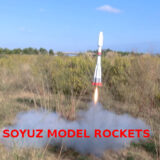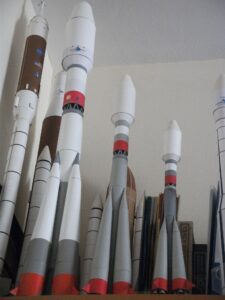Soyuz-Fregat Model Rockets
As you may know the Gaia satellite will be launched by a Soyuz-Fregat rocket. Therefore it was somehow unavoidable for me to build a Soyuz-Fregat model. I am building scale model rocket for several years already – and I am flying them. My job as astrophysicist is mainly computer-based work. Thus, building something with your own hands is a nice alternative approach for your spare time.
The Russian Soyuz rocket has an unusual form with its four conical-shaped booster stages. The more usual form is to have cylindrical stages as most of the space launchers. But it turned out that the conical-shaped boosters of the Soyuz are an advantage for the aerodynamics, especially the gap between the boosters has an effect of a “negative” wing. To add wings to the rocket model is the normal concept to get a stable flight configuration. As I was skeptical about the “negative” wing concept I started with a small, but proven model kit of a Soyuz rocket (Dr. Zooch R-7). This model with a 1:100 scaling is about 46 cm high with a weight of 100 g. The only modification was to replace the Soyuz space ship section by the payload fairing of a Soyuz-Fregat.
The first flight went well, more or less. There was no problem with the aerodynamics, but a small one with the deployment of the parachute used for the purpose of a soft landing. The parachute did not fully deploy as it was partially sticking in the small parachute section. No problem – just build the next larger version of the rocket. As the room for the parachute increases with volume and the weight of the rocket with surface the parachute problem was solved easily. Thus, the 1:72 scale model was easily build and flown several times without any issue.
Note, that both versions of the rocket were powered by high-quality black powder motors. The large version actually uses the largest black powder motor available at the moment. If you want to fly a larger rocket motor you actually have to use a different, more powerful solid propellant. Why aren´t we using the same propellant as used in the Solid Rocket Booster (SRB) of the Space Shuttle? This should be powerful enough, right? This is what I am using for the large Soyuz-Fregat model rocket with 1:50 scale. It is about 1m tall and has a weight of more than 500 g. The propellant, a block of a mixture of aluminum powder and ammonium perchlorate, is loaded in a reusable metal casing like for the real SRBs. Igniting this mixture gives a bright flame and an impressive smoke trail.
Several successful test flights have taken place including a very interesting live streaming test. Now the three rocket models are ready for their real purpose – for display during talks and exhibitions around the Gaia launch date. Launches will be performed for classes – live at the field or streamed live to the audience.
Some videos about these rocketry activities are available:
First flight of the large Soyuz-Fregat model
Live transmission of 2 launches, additional video footage linked in the YouTube description
Latest two Soyuz launches with improved camera work testing flights with lower altitude
Updates are given on my personal blog: http://hvossgaia.wordpress.com .








